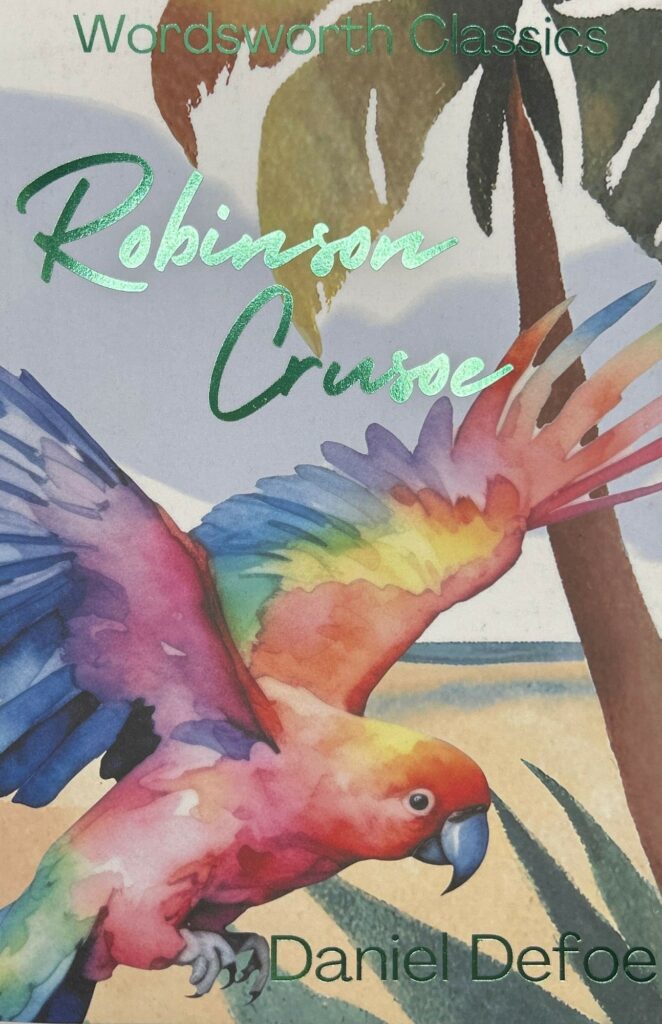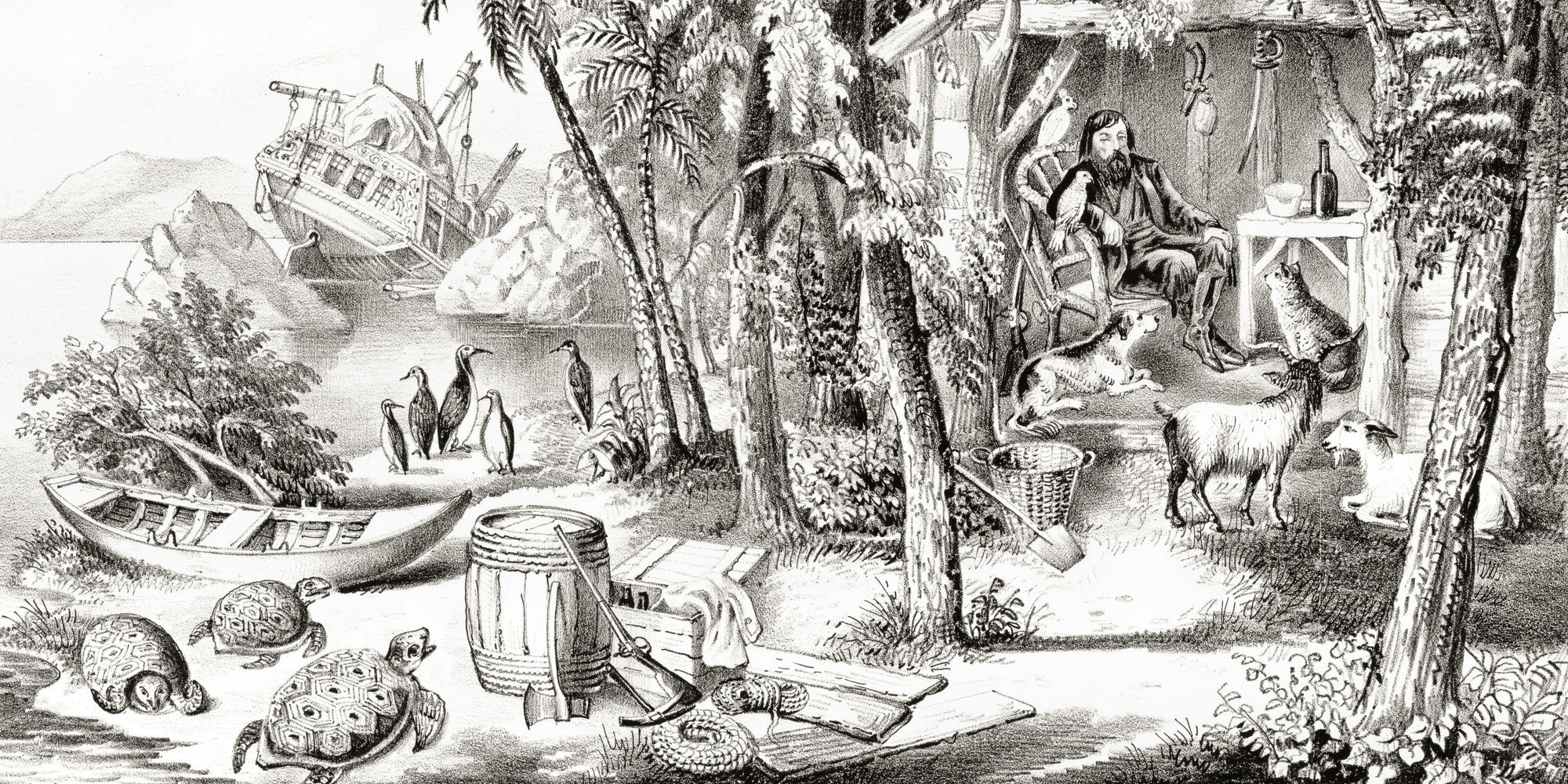
Sally Minogue re-evaluates Robinson Crusoe
The story of Robinson Crusoe is familiar to us in many forms; here Sally Minogue re-evaluates Daniel Defoe’s novel some 300 years after it was first published.
I touched briefly on Robinson Crusoe (1719) in my final ‘Empire’ blog as an example of a novel whose depiction of power relations received a countering fictional response in J. M. Coetzee’s Foe (1986). Here I want to decentre temporarily the (obviously central) theme of imperialism, to consider other dimensions of a work which some consider to be the first English novel. But as this is a novel that raises explicitly issues of slavery and white domination, I’ll return to those at the end of the blog.
Robinson Crusoe is one of those works that has many lives. In one sense, it is surprising that it remains alive in our culture at all, outside academia. It was written at the start of the 18th century, thus distant from us by 300 years (and is set a further 50 years earlier), bears few of the hallmarks we would now recognise as necessary to a novel, never mind one that might engage us, and it is problematised by its depicting as ‘natural’ the relationship of a white master and a black slave. When I texted a friend mentioning that I was embarking on this blog, she replied with the question, ‘How does RC stand up to scrutiny?’ Well, yes – that is the question.
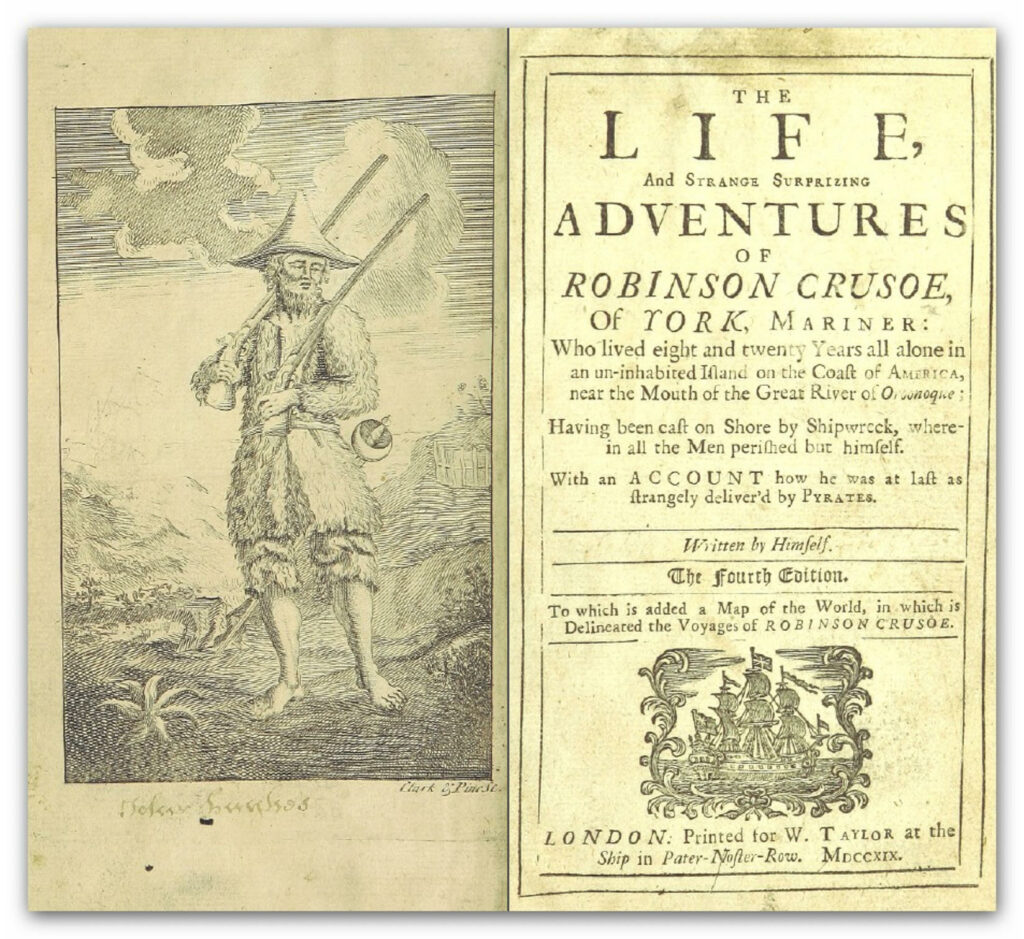
Frontispiece of the original 1719 edition
But scrutiny does not seem to have bothered the countless numbers who have devoured this text, in one form or another. In Defoe’s own day it was an instant success, with five reprintings within four months of its first publication. As Doreen Roberts in her brilliantly wide-ranging introduction to the Wordsworth edition notes, ‘the novel was pirated, plagiarized, abridged and imitated in English, and translated into French, Dutch and German’. It seems to have struck a particular chord in Europe, to the extent that there is a genre of European imitations, the ‘Robinsonades’, which take as their defining characteristic the seclusion of the protagonist(s) on a desert island. Standardly this would feature the isolation of a single individual, as with Crusoe, but one of the best-known examples of the genre, J. D. Wyss’s The Swiss Family Robinson (1812), features a shipwrecked family of father, mother and four boys. A British example of the same genre, R. M. Ballantyne’s The Coral Island (1857), has three young boys marooned on a South Pacific island, finding their way forward without adult support or intervention. The natural conclusion of this line comes with its subversion in William Golding’s dystopian Lord of the Flies (1954), which turns the genre on its head. Again, it is about boys.
An interesting element of this line of development is that increasingly these came to be seen as children’s books, and thus retroactively so did Robinson Crusoe. (Golding’s novel might be seen as a counter-example, but even that has regularly been a set text for adolescents.) The original texts were often abridged and bowdlerised, furnished with stereotypical illustrations, and sold as adventure stories. It’s not surprising that these were often seen as boys’ books, with an appeal to the spirit of adventure and action. Other than the mother Elizabeth, and a minor character Jenny who is rescued from the sea, in The Swiss Family Robinson, all the characters in the aforementioned novels are male. It’s not till Coetzee’s Foe that we get a counteraction to that in the person of Susan Barton who narrates the novel. (Having said that, I remember zipping through these novels as a child and I don’t remember wondering why there were no girls. But then I used to consume with great zest English girls’ boarding school novels, depicting lives which had absolutely no overlap with my own, even though the characters were of my own gender. Children’s fiction in those days thrived on showing worlds other than those of its readers.)
As the ur-text of this genre, Robinson Crusoe certainly has elements of the adventure story. It is Crusoe’s desire to explore – effectively to run away from home against his father’s advice – that leads to the sea wanderings which tip him first into successful trading, then into slavery. These two sides of a common coin make up the long introductory section of the novel (the part of the story most readers forget, or which is truncated in abridged versions). What Defoe shows here is that the wider world is becoming increasingly accessible, even if by the hard and precarious path of the sea voyage. We are shown a world opening up both actually (albeit only to men) and to the imaginations of all readers. There is then an element of the exotic which may still appeal to today’s readers, but not in the way it must have excited 18th century readers. For them, no still or moving images available other than drawings or paintings, some of them fantastical. The written text, reportage or fiction, was their first-hand encounter with the world beyond. It was tantalisingly known, there, yet not-known, not there. Robinson Crusoe filled that imaginative space.
It is generally agreed that Defoe took the idea for his novel from the contemporary and well-known story of Alexander Selkirk, a Scottish buccaneer who on a voyage to the South Pacific on the ship Cinque Ports actually asked his captain to put him off on a desert island, as he thought the ship was being badly managed and was becoming unseaworthy (it did later founder). Selkirk’s life itself had plenty of adventure in it, sailing the high seas during the War of the Spanish Succession, carrying out raiding parties on vulnerable coastal towns and capturing other merchant ships for their valuable cargo. Then there were the dangers of the sea itself. Much of this is reflected in the earlier part of Robinson Crusoe’s story, and no doubt readers would have enjoyed the sensationalism of passages such as these, describing the moment when his ship ran aground:
It is not easy for anyone, who has not been in the like condition, to describe or conceive the consternation of men in such circumstances. We knew nothing where we were, upon what land it was we were driven, whether an island or the main, whether inhabited or not inhabited; and as the rage of the wind was still great … we could not so much as hope to have the ship hold many minutes without breaking in pieces … In a word, we sat looking upon one another, and expecting death every minute, and every man acting accordingly, as preparing for another world. (32)

Illustration from the 1895 edition
They do escape the ship when the winds abate, by taking to a smaller boat, only to meet
a raging wave, mountainlike, [which] came rolling astern of us … In a word, it took us with such a fury, that it overset the boat at once; and separating us, as well from the boat as from one another, gave us not time hardly to say ‘O God’ for we were all swallowed up in a moment. (33)
Crusoe goes on to describe his own struggle in the water, the waves pursuing him as though intent to claim him, ‘as high as a great hill, and as furious as an enemy’, even trying to reclaim him for the sea when he has reached shore.
This is Crusoe’s landing on the desert island, and though I have described it as sensationalist, as would indeed be its effect on the reader, it is also realist in its evocation of the unequal powers of the natural elements and that poor, forked animal, man. The island saves Crusoe, but it is also a potential prison. Adventure story now turns quickly to philosophical and existential drama, as Crusoe fights with his own despair:
The tears would run plentifully down my face … and sometimes I would expostulate with myself, why Providence should thus completely ruin its creatures, and render them so absolutely miserable, so without help abandoned, so entirely depressed, that it could hardly be rational to be thankful for such a life. (47)
That sentence, in both its form and content, reminds us that this is an 18th century work, which explores many Enlightenment debates, played out through the internal conversation of an ordinary, flawed man, a plain representative of the human condition. This, as much as the action-led narrative, has kept drawing the reader to Defoe’s novel across the ages. We are drawn to his resilience, to his urge to find something good in his plight, particularly as it is dramatised within the mind of this one person under the pressure of isolation. Immediately after his passage of despair comes the following:
But something always returned swift upon me to check these thoughts, and reprove me; and particularly one day, walking with my gun in my hand by the seaside, I was very pensive upon the subject of my present condition, when Reason, as it were, expostulated with me t’other way, thus: ‘Well, you are in a desolate condition it is true, but pray remember, where are the rest of you? … Why were you singled out? Is it better to be here, or there?’ … Then it occurred to me again, how well I was furnished for my subsistence. (47)
This touching little ‘exchange’, in which Crusoe projects the character ‘Reason’ to argue with his own pessimistic self, is one we can all recognise, if only from the dark isolated days of lockdown. That was a time when so many of us had to remonstrate with ourselves in the enforced solitariness of our domestic space – or even, when allowed, walking alone by the seaside – and to try to find some human good even within bleak circumstances. The presence of death at that time, too, led to a deeper reconsideration of life. And it is precisely this that we see played out in a powerful and much more extended form in Robinson Crusoe. But it is a saving grace of human nature that cheerfulness will keep breaking in, and as readers we are touched by Crusoe’s relentless struggle to be optimistic, and his instinct to survive in such testing conditions of isolation.[1] ‘As my reason began now to master my despondency’ (49), Crusoe decides to make a reckoning, writing down with the pen, ink and paper he has garnered from the foundered ship the pros and cons of his position, and comes to the admirable conclusion that:
there was scarce any condition in the world so miserable, but there was something negative or something positive to be thankful for in it, and let this stand as a direction from the experience of the most miserable of all conditions in this world, that we may always find in it something to comfort ourselves from, and to set in the description of good and evil on the credit side of the account. (50)
We might not all be able to emulate this outlook, but the courage required for it, and indeed the triumph of hope over experience that it represents, make Crusoe attractive to us, even when – or perhaps because – we see all his concomitant faults.
This is why the two cataclysmic events, first the appearance of the single footprint in the sand, and very many years later, the acquisition of a companion, resound through the novel, for both break the profound isolation which is at the core of all Crusoe’s actions, thoughts and feelings. In truth, the first is the briefest of passages (117-118), and occurs when Crusoe has been on the island 15 years. The second comes on p.156, but in terms of Crusoe’s time on the island, it is at least 24 years into his stay. Thus there are only 40 pages (out of 235) and, in time, 4 years, in which Crusoe and Friday are alone together on the island. Abridged versions have no doubt led to readerly perceptions that Friday’s arrival follows closely on the footprint, and is connected to it, but that is not the case. Nonetheless, imaginatively the footprint reverberates through the novel like the thunder Crusoe feels himself struck by when he sees it. Unable to make sense of what is unmistakably a human footprint – but a single one, alone – he is ‘terrified to the last degree’, his ‘affrighted imagination’ presents wild possibilities, and he flees into his dwelling ‘like one pursued’. (118) We can sympathise with this for after all here is something that lies outside his powers of reason to explain. But we sympathise even more when he reflects regretfully, and again uncomprehendingly, on his own fearful responses:
For I, whose only affliction was that I seemed banished from human society, that I was alone, circumscribed by the boundless ocean, cut off from mankind, and condemned to what I called silent life …; that to have seen one of my own species would have seemed to me a raising me from death to life, and the greatest blessing that Heaven itself … could bestow; I say, that I should now tremble at the very apprehensions of seeing a man, and was ready to sink into the ground at but the shadow or silent appearance of a man’s having set his foot in the island! (120)
Poor Crusoe – tormenting himself with fear, and then tormenting himself because of being fearful! As happens frequently in a text informed by religious belief, God comes to his rescue, in the form of accepting whatever is His will; but at the same time he makes sure his dwelling is well defended, turning it into a fortress – just in case.
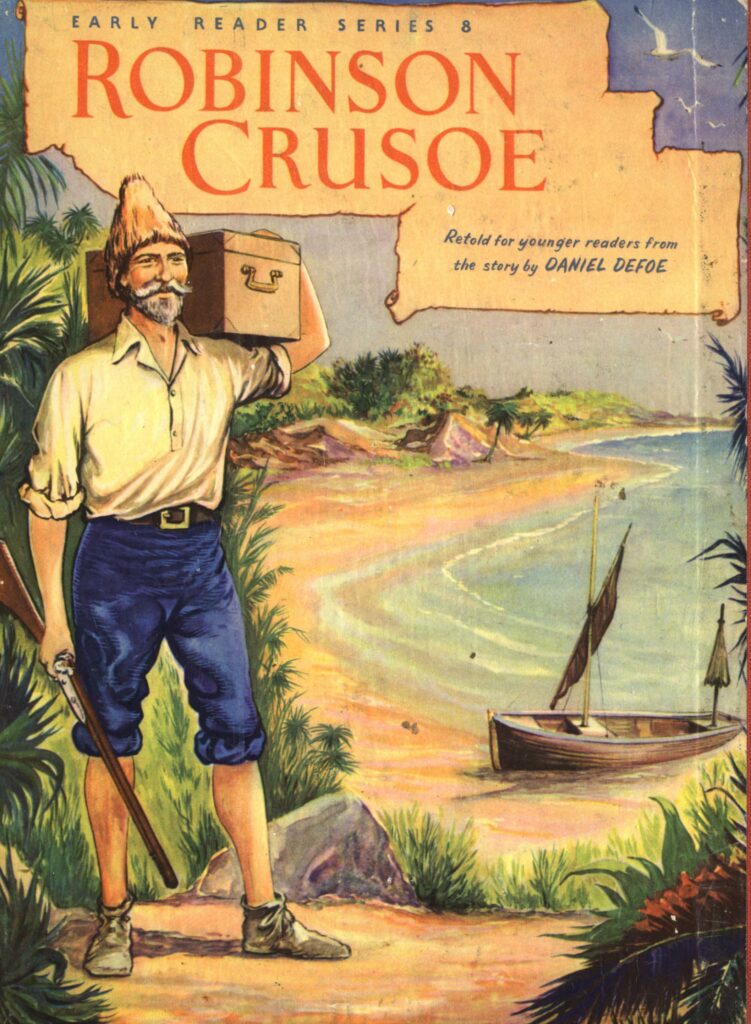
1960s Early Reader edition
I think we are moved by Crusoe because we see in him the frailties of a complicated being, attempting in the spirit of the age to listen to Reason but drawn to superstition and magical thinking. Early in his stay on the island, when he is doing his best to furnish the practical needs of his situation, he comes upon ‘some few stalks of something green shooting out of the ground’ which he discovers are ‘perfect green barley’. This thrills and amazes him, as he sees in it the generosity of a benevolent God whose eyes are turned on him alone, and the growing grain ‘directed purely for my sustenance on that wild miserable place’. (59) But in this retrospective narrative, Crusoe has already told us in preparation for this find, that he had emptied out the husks and dust from a bag that had held corn, in just this spot under some rocks. He is scrupulously honest in telling us this prior to the recounting of his discovery, in not concealing that he had forgotten it and being open about his wonderment, then further exposing himself by admitting that ‘my religious thankfulness to God’s Providence began to abate too’ on remembering the part played by his own actions. His ratiocinations come full circle when he concludes that it is just as providential that he should have carelessly thrown the husks where they were sheltered from rats, and just before the rains came, so that they survived and were watered, and sprouted.
These green sprouts are of course more than just themselves. Crusoe’s reaction reminds us of the Ancient Mariner blessing the water snakes, and it also accords with the natural delight of seeing growing, living things where before there were just rocks and dust. But there is also that dimension of being subject to and wanting to appease the powers of nature, as all who have worked the land at the mercy of the elements, even to this day, are aware. All the better for the ever-practical Crusoe if these shoots will eventually provide grain for bread; for there is something magical about this too.
And so to Crusoe’s ‘man’, Friday. That man would have had his own name, but for Crusoe (and the reader) he is forever ‘Friday’, even ‘Man Friday’ in popular thought, and for Crusoe, ‘my man Friday’. Likewise Crusoe is to him forever ‘Master’. Mohammed Ali taught us all the importance of names when he taunted opponent Ernie Terrell in the ring in 1967, after Terrell had repeatedly insisted on calling him Cassius Clay (in Ali’s view, his ‘slave’ name): “What’s my name? What’s my name?” Names, language, beliefs all go by the board when Crusoe rescues ‘Friday’ from the cannibals, combining a religious motive with a pragmatic one: ‘It came now very warmly upon my thoughts, and indeed irresistibly, that now was the time to get me a servant, and perhaps a companion or assistant, and that I was called plainly by Providence to save this poor creature’s life.’ (155) Then in a neat microcosm of colonial practices, we see ‘Friday’ subsumed into Crusoe’s values, even submitting himself deliberately to them. In his first act, ‘he came close to me, and then he kneeled down again, kissed the ground, and laid his head upon the ground, and taking me by the foot, set my foot upon his head. This, it seems, was in token of swearing to be my slave forever.’(156) Very convenient for Mr Crusoe.
So now we must upend our benevolent view of Crusoe, as we see him simply accept Friday’s self-subjection, and assume as natural in himself the role of master. And this reminds us of several passages in the early part of the novel where Crusoe refers casually to buying and selling negroes for ‘trifles’:
I had frequently given them an account of my two voyages to the coast of Guinea, the manner of trading with the negroes there, and how easy it was to purchase upon the coast for trifles – such as beads, toys, knives, scissors, hatchets, bits of glass, and the like – not only gold-dust, Guinea grains, elephants’ teeth, etc, but negroes, for the service of the Brazils, in great numbers. (28)
Now if Crusoe were an unthinking creature, the pig satisfied rather than Socrates dissatisfied, this purely economic view of fellow humans might seem consistent. But as the whole run of the novel shows, Crusoe is constantly struggling with ideas of virtue in the social order. Even if his is a one-man social order, nonetheless he considers the arguments, including those round religious belief, and organises his life according to his conclusions. Furthermore, only days after he has rescued Friday and brought him into his service, he reflects on Friday’s goodness. And he can’t get round the idea that God has chosen to:
take from so great a part of the world of his Creatures the best uses to which their faculties and the powers of their souls are adapted, yet that He has bestowed upon them the same powers, the same reason, the same affections, the same sentiments of kindness and obligation, the same passions and resentments of wrongs, the same sense of gratitude, sincerity, fidelity, and all the capacities of doing good, and receiving good, that he has given to us. (161)
He concludes that if God had given his knowledge to ‘so many millions of [pagan] souls, … if I might judge by this poor savage, [they] would make a much better use of it than we did.’ This openness to reconsider his own assumptions has been evident earlier when he looks in a relativist way at the practices of the cannibals: ‘They think it no more a crime to kill a captive taken in war, than we do to kill an ox; nor to eat human flesh, than we do to eat mutton’. (131) There follows a highly rational account of the wrongness of his making a moral judgement here.
In spite of these insights, Crusoe is so convinced of the rightness of his own Christian position that, though he sees Friday’s goodness, he can’t allow that Friday’s pagan beliefs might as well inform and generate that goodness as Crusoe’s Christian ones. Nor do these reflections on ‘Friday’’s goodness lead him to make any change in the master/servant relationship. Instead, ‘Friday’’s submissiveness is accepted as natural, just as Crusoe’s mastery is. No thought is given to the fact that ‘Friday’ has more right to the island than Crusoe, given that he is a local indigenous person and Crusoe an outsider. Crusoe sees his right as God-given.
There is so much here that prefigures the movements of colonialism. Crusoe is the benevolent master; not only did he save ‘Friday’’s life but he can now offer him a better life than that he had. Clothes to cover his nakedness (‘it is true he went awkwardly in these things at first’), flesh of animals to eat to replace the flesh of humans (cannibalism being attributed to both those who had captured ‘Friday’ originally, but also to ‘Friday’ himself), a new language, and eventually a new religion. All, of course, predicated on the fact that Crusoe is master and Friday servant. That Friday is so good and loving is in itself necessary to the preservation of that relationship – if he rebelled, that would be evidence to Crusoe of his badness. Instead he has the perfect subject:
Never man had a more loving, sincere servant than Friday was to me; without passions, sullenness, or designs, perfectly obliged and engaged; his very affections were tied to me, like those of a child to a father. (160)
Thus when Crusoe finally leaves the island, he naturally follows, but as the novel drifts to its close, ‘Friday’ drifts in and out of the narrative and is never given a firm farewell. That will come in the early stages of Defoe’s immediate sequel, The Farther Adventures of Robinson Crusoe (1719). But that is another story.
Page references are to Wordsworth Editions Robinson Crusoe. Wordsworth also publish Moll Flanders by Daniel Defoe.
[1] Dr Johnson reports this remark being made to him by Oliver Edwards, once his contemporary at Cambridge: “You are a philosopher, Dr Johnson. I have tried too in my time to be a philosopher; but, I don’t know how, cheerfulness was always breaking in.” James Boswell, The Life of Doctor Johnson.
Main Image: Robinson Crusoe with his pets. Illustration from Currier & Ives edition, New York, 1874 Credit: Old Images / Alamy Stock Photo
Image 1 above: Frontispiece of the original 1719 edition. Credit: BLM Collection / Alamy Stock Photo
Image 2 above: ‘Pulling as well as we could towards the land’. Illustration from the 1895 edition. Credit: Lebrecht Music & Arts / Alamy Stock Photo
Image 3 above: 1960s Early Reader edited edition for children. Credit: Retro AdArchives / Alamy Stock Photo
Books associated with this article
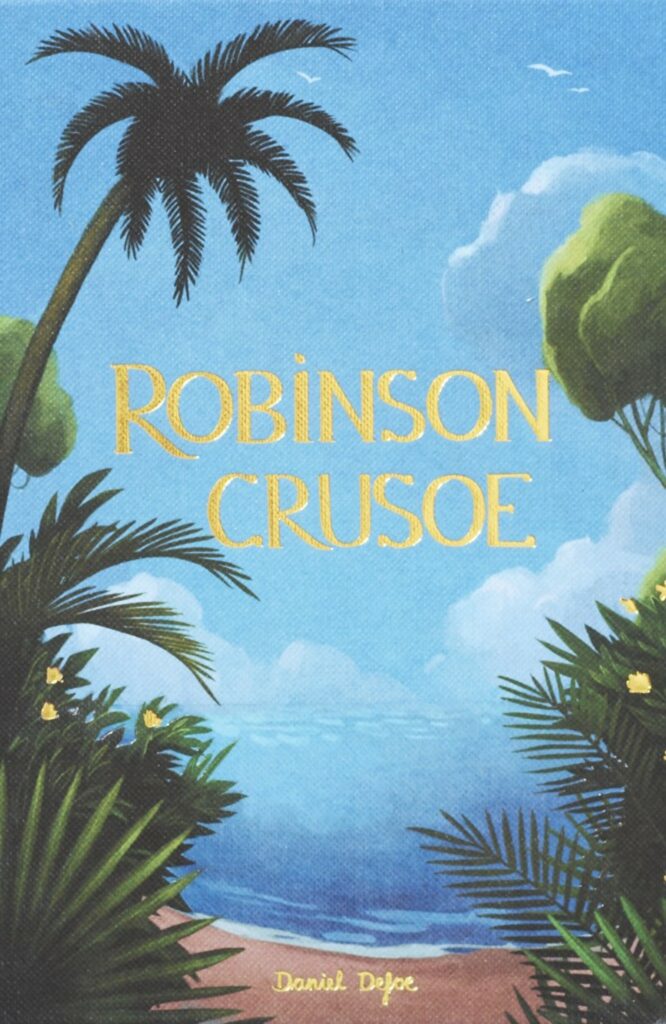
Robinson Crusoe (Collector’s Edition)
Daniel Defoe
